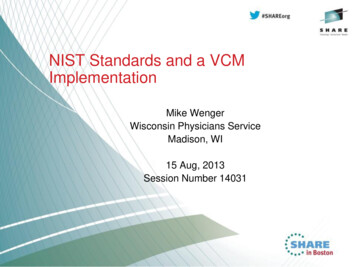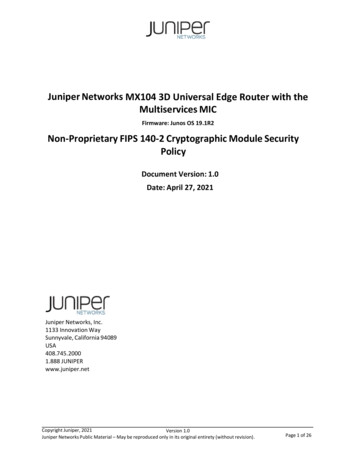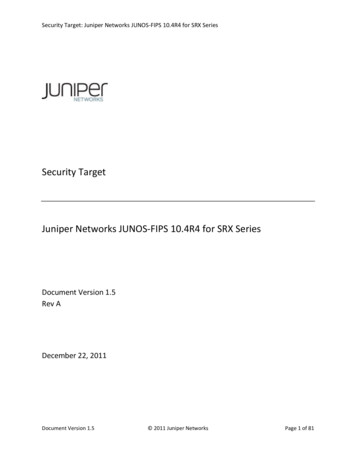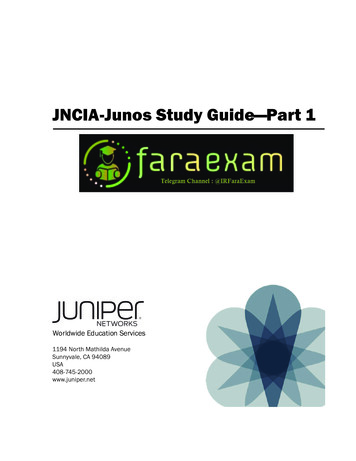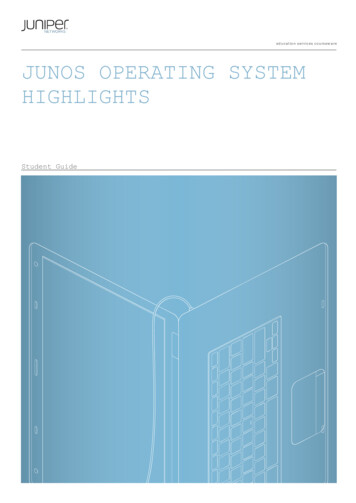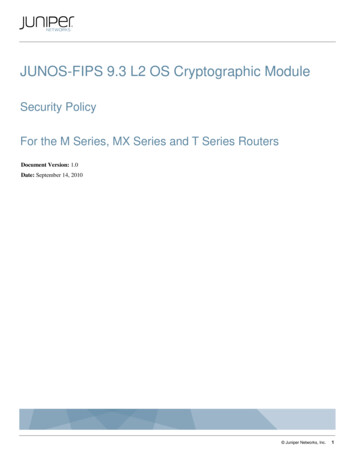
Transcription
JUNOS-FIPS 9.3 L2 OS Cryptographic ModuleSecurity PolicyFor the M Series, MX Series and T Series RoutersDocument Version: 1.0Date: September 14, 2010 Juniper Networks, Inc.1
JUNOS-FIPS 9.3 L2 OS Cryptographic ModuleTable of ContentsTable of Contents . 2List of Tables . 21. Module Overview . 32. Security Level . 53. Modes of Operation . 5Approved Mode of Operation . 5Non-FIPS Mode of Operation . 64. Ports and Interfaces . 65. Identification and Authentication Policy . 6Assumption of Roles . 66. Access Control Policy . 9Roles and Services . 9Unauthenticated Services . 10Definition of Critical Security Parameters (CSPs) . 10Definition of Public Keys . 12Definition of CSP Modes of Access . 137. Operational Environment . 148. Security Rules . 149. Physical Security Policy . 15Physical Security Mechanisms . 15Tamper Label Evidence . 1610. Mitigation of Other Attacks Policy . 1611. Acronyms . 16Appendix A, Tamper Label Placements . 18Tamper Label Placement Label Application Instructions. 18List of TablesTable 1.Table 2.Table 3.Table 4.Table 5.Table 6.Table 7.Table 8.Table 9.Table 10.JUNOS-FIPS 9.3 L2 OS Series/Platform/RE. 3Security Level . 5Roles and Required Identification and Authentication . 7Strengths of Authentication Mechanisms . 8Services Authorized for Roles . 9Table of CSPs . 10Table of Public Keys . 12CSP Access Rights within Roles & Services . 13Inspection/Testing of Physical Security Mechanisms . 16Mitigation of Other Attacks . 16 Juniper Networks, Inc.2
JUNOS-FIPS 9.3 L2 OS Cryptographic Module1. Module OverviewThe JUNOS-FIPS 9.3 L2 OS Cryptographic Module for M Series, MX Series, and T Series routers (hereafter referred to as JUNOSFIPS 9.3 L2 OS) executes on a multiple-chip embedded routing engine with Juniper Networks M Series Multiservice Edge Routers,Juniper Networks MX Series 3D Universal Edge Routers, and Juniper Networks T Series Core Routers. The validated version ofJUNOS-FIPS 9.3 L2 OS is 9.3R2.8; the image is junos-juniper-9.3R2.8-fips.tgz. See Table 1 below for hardware platform specifics.JUNOS-FIPS 9.3 L2 OS is a release of the JUNOS operating system, the first routing operating system designed specifically for theInternet. JUNOS is currently deployed in the largest and fastest-growing networks worldwide. A full suite of industrial-strengthrouting protocols, a flexible policy language, and a leading MPLS implementation efficiently scale to large numbers of networkinterfaces and routes.JUNOS-FIPS 9.3 L2 OS, the logical cryptographic boundary, meets the requirements of the FIPS Publication 140-2. JUNOS-FIPS 9.3L2 OS is a firmware-only module designed to operate on Routing Engine (RE) hardware, which is equivalent to PC hardware. Thecryptographic module’s operational environment is a limited operational environment.The physical cryptographic boundary is formed by embedding a RE within a platform chassis, which is provided by the M Series, MXSeries, and T Series chassis. The combinations of the configurations are shown in Table 1. Figure 1 below represents the moduleboundary. Additional boundary configuration requirements are specified in Appendix A.Table 1.JUNOS-FIPS 9.3 L2 OS Series/Platform/RESeriesPlatformRouting EngineM SeriesM40eRE-A-1000-2048 - 1GHz processor with 2GB of memoryM120RE-A-1000-2048 - 1GHz processor with 2GB of memoryM120RE-A-2000-4096 - 2GHz processor with 4GB of memoryM320RE-A-1000-2048 - 1GHz processor with 2GB of memoryM320RE-A-2000-4096 - 2GHz processor with 4GB of memoryMX240RE-S-2000-4096 - 2GHz processor with 4GB of memoryMX480RE-S-2000-4096 - 2GHz processor with 4GB of memoryMX960RE-S-2000-4096 - 2GHz processor with 4GB of memoryT320RE-A-2000-4096 - 2GHz processor with 4GB of memoryT640RE-A-2000-4096 - 2GHz processor with 4GB of memoryT1600RE-A-2000-4096 - 2GHz processor with 4GB of memoryMX SeriesT Series Juniper Networks, Inc.3
JUNOS-FIPS 9.3 L2 OS Cryptographic ModuleFigure 1.Diagram of the Cryptographic ModulePlatform Chassis(PCM) Platform Chassis - Routing Engine Install SlotRouting EngineData Input(LCM) JUNOS-FIPS 9.3 L2 OS 9.3R2.8Data OutputControl InputStatus OutputCPURAMFixedDiskEthernetCOMControllerLogical cryptographic module (LCM)boundaryPhysical cryptographic module (PCM)boundary Juniper Networks, Inc.4
JUNOS-FIPS 9.3 L2 OS Cryptographic Module2. Security LevelThe cryptographic module, which is a multiple-chip embedded embodiment, meets the overall requirements applicable to Level 2security of FIPS 140-2.Table 2.Security LevelSecurity Requirements SectionLevelCryptographic Module Specification2Module Ports and Interfaces2Roles, Services and Authentication2Finite State Model2Physical Security2Operational EnvironmentN/ACryptographic Key Management2EMI/EMC2Self-Tests2Design Assurance3Mitigation of Other AttacksN/A3. Modes of OperationApproved Mode of OperationThe cryptographic module supports FIPS-Approved algorithms as follows: AES 128, 192, 256 for encryption/decryption ECDSA with Curve P-192 for digital signature generation and verification DSA with 1024-bit keys for digital signature generation and verification RSA with 1024 or 2048-bit keys for digital signature generation and verification Triple-DES (three key) for encryption/decryption SHA-1 for hashing SHA-2 for hashing (SHA-224, SHA-256, SHA-384, SHA-512) HMAC-SHA-1 HMAC-SHA-256 AES-128-CMAC FIPS 186-2 RNG (with Change Notice)The cryptographic module also supports the following non-Approved algorithms: RSA with 1024-bit keys (key wrapping; key establishment methodology provides 80 bits of encryption strength) MD5 for hashing (used during authentication) Juniper Networks, Inc.5
JUNOS-FIPS 9.3 L2 OS Cryptographic Module Diffie-Hellman with 1024-bit keys (key agreement; key establishment methodology provides 80 bits of encryptionstrength) Non-Approved RNG (used to seed Approved FIPS 186-2 RNG)The cryptographic module supports the commercially available TLS, IKEv1, and SSH-2 protocols for key establishment in accordancewith FIPS 140-2 Annex D.The cryptographic module relies on the implemented deterministic random number generator (RNG) that is compliant with FIPS 1862 for generation of all cryptographic keys in accordance with FIPS 140-2 Annex C.Non-FIPS Mode of OperationThe cryptographic module does not provide a non-Approved mode of operation.4. Ports and InterfacesThe cryptographic module supports the following physical ports and corresponding logical interfaces: Ethernet: Data Input, Data Output, Control Input, Status Outputs Serial: Data Input, Data Output, Control Input, Status Outputs Power interface: Power Input LEDs: Status OutputThe flow of input and output of data, control, and status is managed by the cryptographic module’s defined service interfaces. Thesephysical interfaces are mapped to the logical interfaces which include SSH-2, TLS (Ethernet) and Console (Serial).5. Identification and Authentication PolicyAssumption of RolesThe cryptographic module supports six distinct operator roles as follows: User Cryptographic Officer (CO) AS2-FIPS PIC RE-to-RE IKE Peer Protocol PeerThe cryptographic module shall enforce the separation of roles using either identity-based or role-based operator authentication; thecryptographic module meets Level 2 requirements because identity-based authentication is not enforced for all authorized services. Juniper Networks, Inc.6
JUNOS-FIPS 9.3 L2 OS Cryptographic ModuleTable 3.Roles and Required Identification and AuthenticationRoleType of AuthenticationUserIdentity-based operator authenticationAuthentication Data Via Console: Username and password Via TLS: Username and password Via SSH-2: Password or RSA signature verification orDSA signature verificationCryptographic OfficerRole-based authentication Via RADIUS or TACACS : pre-shared secret, minimum10 charactersIdentity-based operator authentication Via Console: Username and password Via TLS: Username and password Via SSH-2: Password or RSA signature verification orDSA signature verificationRole-based authentication Via RADIUS or TACACS : pre-shared secret, minimum10 charactersAS2-FIPS PICIdentity-based operator authenticationSerial Number (6 bytes) and password (32 bytes)RE-to-REIdentity-based operator authenticationPre-shared keysThe RE role will use pre-shared keys for securecommunication.IKE PeerIdentity-based operator authenticationIKE pre-shared keysUses IKE to establish keys to be used by the PIC for IPseccommunication with IPsec clients.Protocol PeerRole-based authenticationWill use pre-shared keys to send encrypted traffic. UsesTCP/UDP MD5 MAC only to authenticate operator.Alternatively, a manually configured IPsec SA can be usedfor authentication. Juniper Networks, Inc.7
JUNOS-FIPS 9.3 L2 OS Cryptographic ModuleTable 4.Strengths of Authentication MechanismsAuthentication MechanismStrength of MechanismUsername and passwordThe module enforces 10-character passwords (at minimum) chosen from the 96 human readable ASCII characters.The module enforces a timed access mechanism as follows: For the first two failedattempts (assuming 0 time to process), no timed access is enforced. Upon the thirdattempt, the module enforces a 5-second delay. Each failed attempt thereafter resultsin an additional 5-second delay above the previous (e.g. 4th failed attempt 10-seconddelay, 5th failed attempt 15-second delay, 6th failed attempt 20-second delay, 7thfailed attempt 25-second delay).This leads to a maximum of 7 possible attempts in a one-minute period for each getty.The best approach for the attacker would be to disconnect after 4 failed attempts, andwait for a new getty to be spawned. This would allow the attacker to perform roughly9.6 attempts per minute (576 attempts per hour/60 mins); this would be rounded downto 9 per minute, because there is no such thing as 0.6 attempts. Thus the probability ofa successful random attempt is 1/9610, which is less than 1/1 million. The probability ofa success with multiple consecutive attempts in a one-minute period is 9/(9610), whichis less than 1/100,000.RSA signatureThe module supports RSA (1024 or 2048-bit), which has a minimum equivalentcomputational resistance to attack of either 280 or 2112 depending on the modulus size.Thus the probability of a successful random attempt is 1/(280) or 1/ (2112), which areboth less than 1/1,000,000. The probability of a success with multiple consecutiveattempts in a one-minute period is 5.6e7/(280) or 5.6e7/(2112), which are both less than1/100,000.DSA signatureThe module supports DSA (1024-bit only) which have an equivalent computationalresistance to attack of 280. Thus the probability of a successful random attempt is1/ 280, which is less than 1/1,000,000. The probability of a success with multipleconsecutive attempts in a one-minute period is 5.6e7/(280), which is less than1/100,000.AS2-FIPS PIC passwordThe module supports 32 byte passwords to authenticate the PIC. Thus the probabilityof a successful random attempt is 1/ (25532), which is less than 1/1,000,000. Theprobability of a success with multiple consecutive attempts in a one minute period is4,940,716 /(25532), which is less than 1/100,000.RE-to-RE pre-shared keysThe module uses 160-bit HMAC keys for RE-to-RE authentication. Thus the probabilityof a successful random attempt is 1/(2160), which is less than 1/1,000,000. Theprobability of a success with multiple consecutive attempts in a one-minute period is54,347,880/(2160), which is less than 1/100,000.IKE pre-shared keysThe module uses 160-bit HMAC keys for RE-to-RE authentication. Thus the probabilityof a successful random attempt is 1/(2160), which is less than 1/1 million. Theprobability of a success with multiple consecutive attempts in a one minute period is54,347,880/(2160), which is less than 1/100,000.Protocol peer pre-shared keysThe module supports TCP-MD5 with a 128-bit pre-shared key. Thus the probability ofa successful random attempt is 1/ (2128), which is less than 1/1,000,000. Theprobability of a success with multiple consecutive attempts in a one minute period is54,347,880/(2128), which is less than 1/100,000. Juniper Networks, Inc.8
JUNOS-FIPS 9.3 L2 OS Cryptographic Module6. Access Control PolicyRoles and ServicesTable 5.Services Authorized for RolesRoleAuthorized ServicesUser: Configuration Management: Allows the user to configure the router.Configures and monitors the routervia the console, SSH-2, or TLS. Router Control: Allows the user to modify the state of the router. (Example: shutdown,reboot) Status Checks: Allows the user to get the current status of the router JUNOScript: Provides script handling service for module via SSH-2 or TLS session. SSH-2: Provides encrypted login via the SSH-2 protocol. TLS: Provides encrypted login via the TLS protocol. Console Access: Provides direct login access via the console.Cryptographic Officer: Configuration Management: Allows the CO to configure the router.Configures and monitors the REvia the console, SSH-2, or TLS.Also has permissions to view andedit secrets within the RE. Router Control: Allows the user to modify the state of the router. (Example: shutdown,reboot) Status Checks: Allows the user to get the current status of the router. Zeroize: Allows the user to zeroize the configuration (all CSPs) within the module. Load New Software: Allows the verification and loading of new software into the router.Note: Loading of software invalidates the module’s FIPS 140-2 validation. JUNOScript: Provides script handling service for module via SSH-2 or TLS session. SSH-2: Provides encrypted login via the SSH-2 protocol. TLS: Provides encrypted login via the TLS protocol. Console Access: Provides direct login access via the console.AS2-FIPS PIC Receives SAs: Allows the PIC to receive the SAs associated with a particular IPsectunnel. Secure IPC Tunnel: Allows the PIC to communicate with the RE using a secure tunnel.RE-to-REThe RE role is able to communicatewith other REs to enable failovercapabilities. Configuration Management: Allows propagation of configuration database to the backupRE. Router Control: Allows the master RE to control the state of the backup RE. Status Checks: This service will allow the user to get the current status of the router(ports, number of packets, uptime, and so forth) Secure Transport: Allows the master RE to communicate with the backup RE using asecure IPsec connection. Secure IPC Tunnel: Allows the PIC to communicate with the RE using a secure tunnel. Juniper Networks, Inc.9
JUNOS-FIPS 9.3 L2 OS Cryptographic Module Key Agreement: Allows the negotiation of keys for use with an IPsec tunnel.IKE PeerThis role performs IKE negotiationwith the RE.The IKE peer will create SAs for theAS2-FIPS PIC to use when usingIPsec with a VPN client incyberspace.Protocol Peer Mutual Authentication: Allows validating a known protocol peer.This role allows remote router tocommunicate with the RE viastandard networking protocols.The supported routing protocols(BGP, ISIS, LDP, MSDP, OSPF,RIP2, RSVP, VRRP, and NTP)authenticate peers to each otherfor purpose of updating routingtables. Protocol Exchange: Allows the peers to communicate using an agreed-upon protocol. Secure Protocol Transport: Allows IPsec connection between protocol peer and router.Unauthenticated ServicesThe cryptographic module supports the following unauthenticated services: PIC Software Image Load: Downloads PIC software image to PIC. Receive Service Set Configuration: Allows the PIC to receive service set configuration database. Show Status: Provides the current status of the cryptographic module. Self-tests: Executes the suite of self-tests required by FIPS 140-2. Routing Protocols: Unauthenticated routing protocols (e.g., TCP, UDP) SNMP Traps (Status)Definition of Critical Security Parameters (CSPs)Table 6.Table of CSPsCSPDescriptionSSH-2 Private Host KeyThe first time SSH-2 is configured, the key is generated. RSA, DSA.Used to Identify the host. 1024-bit length set as minimum.SSH-2 Session KeySession keys used with SSH-2, TDES (3 key), AES 128, 192, 256,HMAC-SHA-1 key (160), DH Private Key 1024TLS Host Certificate, Private PortionX.509 certificates for TLS for authentication. RSA or DSATLS Session ParametersSession keys used with TLS, TDES (2 or 3 key), AES 128, 192, 256,HMAC-SHA-1; Pre-master SecretUser Authentication KeyHMAC-SHA-1 KeyUsed to authenticate users to the module.CO Authentication KeyHMAC-SHA-1 KeyUsed to authenticate COs to the module. Juniper Networks, Inc.10
JUNOS-FIPS 9.3 L2 OS Cryptographic ModuleCSPDescriptionIPsec SAsSession keys used within IPsec.TDES (3 key), HMAC-SHA-1IKE Session ParametersNonces, DH Private Key 1024-bit keys, TDES, HMAC-SHA-1, usedwithin IKESecure IPC (Internal) Session KeyTDES (3 Key)Used to communicate securely between the RE and the PICRE-to-RE Authentication KeyHMAC Key (Manual IPsec SA)160 bit key with 96 bit truncated MAC.RE-to-RE Encryption KeyTDES key (Manual IPsec SA)Protocol Peer Authentication KeysTCP-MD5 key to authenticate the routing peer role for the followingprotocols:BGP, ISIS, LDP, MSDP, OSPF, RIP2, RSVP, VRRP, NTP, APSCPASPIC password32 byte passwordRADIUS shared secretUsed to authenticate COs and Users (10 chars minimum)This includes the Authentication Data BlockTACACS shared secretUsed to authenticate COs and Users (10 chars minimum)This includes the Authentication Data BlockManual SA for PICEntered into the RE, which is then passed over to the PIC for use byPIC with IPSECRNG StateInternal state and seed key of RNG Juniper Networks, Inc.11
JUNOS-FIPS 9.3 L2 OS Cryptographic ModuleDefinition of Public KeysTable 7.Table of Public KeysKeyDescription/UsageSSH-2 Public Host KeyFirst time SSH-2 is configured, the key is generated. RSA (1024 or 2048-bit),DSA. Identify the host.TLS Host Certificate, Public PortionX.509 certificates for TLS for authentication. RSA (1024 or 2048-bit) or DSAUser Authentication Public KeysUsed to authenticate users to the module. RSA (1024 or 2048-bit) or DSACO Authentication Public KeysUsed to authenticate CO to the module. RSA (1024 or 2048-bit) or DSAJuniperRootCARSA 2048-bit X.509 certificateUsed to verify the validity of the Juniper image at software load and also atruntime for integrity.EngineeringCARSA 2048-bit X.509 certificateUsed to verify the validity of the Juniper image at software load and also atruntime for integrity.PackageCARSA 2048-bit X.509 certificateUsed to verify the validity of the Juniper image at software load and also atruntime for integrity.PackageProductionRSA 2048-bit X.509 certificateCertificate that holds the public key of the signing key that was used togenerate all the signatures used on the packages and signature lists.RE RSA Verify Key (Public Authentication key)RSA 1024-bit key sent to the PIC to sign data to allow the PIC toauthenticate to the RE by having the PIC sign data that is verified by the RE.PIC RSA Verify (Public Authentication) KeyRSA 1024-bit key to allow the RE to authenticate to the PIC by signing dataand having the PIC verify the signature.PIC RSA Encrypt KeyRSA 1024-bit key used to encrypt the TDES session key.RE RSA Encrypt KeyRSA 1024-bit key sent to the PIC; note that the PIC never uses this key.DH Public KeysUsed within IKE and SSH-2 for key establishment. Juniper Networks, Inc.12
JUNOS-FIPS 9.3 L2 OS Cryptographic ModuleDefinition of CSP Modes of AccessTable 8 defines the relationship between access to CSPs and the different module services. The modes of access shown in the table aredefined as follows:Table 8.CSP Access Rights within Roles & rot.PeerXCryptographic Keys and CSPAccess OperationR Read, W Write, D DeleteConfigurationManagementAll CSPs (R, W, D)ConfigurationManagementNo access to CSPsXConfigurationManagementAll CSPs (R, W)XXXXRouter ControlNo access to CSPsXXXStatus ChecksNo access to CSPsZeroizeAll CSPs (D)Receives SAsRelevant IPsec SAs (R)Key AgreementIPsec SAs (R)XMutual AuthenticationRelevant Authentication data: (R)XProtocol Exchange(OSPF, VRRP, etc)No access to CSPsXLoad New SoftwareNo access to CSPsXJUNOScriptAll CSPs (R, W, D)XJUNOScriptNo access to CSPsXXSSH-2SSH-2 session key (R)XXTLSTLS session parameters (R)XXConsole AccessCO Authentication Key, UserAuthentication Key (R)Secure IPC TunnelSecure IPC (Internal) Session Key(R)XXXXX Juniper Networks, Inc.13
JUNOS-FIPS 9.3 L2 OS Cryptographic ModuleXXSecure transportRE-to-RE Encryption Key, RE-to-REAuthentication Key (R)Secure ProtocoltransportProtocol Peer Authentication Keys(R)7. Operational EnvironmentThe FIPS 140-2 Area 6 Operational Environment requirements are not applicable because the cryptographic module is a limitedoperational environment.8. Security RulesThe cryptographic module’s design corresponds to the cryptographic module’s security rules. This section documents the securityrules enforced by the cryptographic module to implement the security requirements of this FIPS 140-2 Level 2 module.1.2.3.4.The cryptographic module shall provide six distinct operator roles. These are the User role, the Cryptographic Officer role, RE-toRE role, AS2-FIPS PIC role, IKE Peer role, and Protocol Peer role.The cryptographic module shall support both role-based and identity-based authentication mechanisms.Authentication of identity to an authorized role is required for all services that modify, disclose, or substitute CSPs, use Approvedsecurity functions, or otherwise affect the security of the cryptographic module.The cryptographic module shall perform the following tests: Power up testsA. Cryptographic algorithm v.DES - KAT1TDES - KATAES - KATAES - CMAC KATSHA-1 KATSHA-224, 256, 384, 512 KATHMAC-SHA-1 KATHMAC-SHA-256 KATECDH KATECDSA pairwise consistency test (sign/verify) and KATRSA pairwise consistency test (sign/verify and encrypt/decrypt) and KATDSA pairwise consistency test (sign/verify) and KATFIPS 186-2 RNG KATKDF-IKEv1 KATB. Firmware integrity test:i.RSA digital signature verification (PKCS1.5, 2048-bit key, SHA-1) and SHA-1 hashverificationC. Critical functions tests 1i.Verification of Limited Environmentii.Verification of Integrity of Optional PackagesConditional testsA. Pairwise consistency testsThe DES function is used to implement TDES and is not otherwise available for use in the cryptomodule. Juniper Networks, Inc.14
JUNOS-FIPS 9.3 L2 OS Cryptographic Modulei.ECDSA Pairwise Consistency testii.RSA pairwise consistency test (sign/verify and encrypt/decrypt)iii.DSA pairwise consistency test (sign/verify)B. Firmware load test: RSA digital signature verification (2048-bit key)C. Manual key entry test: duplicate key entries testD. Continuous random number generator test: performed on the Approved FIPS 186-2, Appendix 3.1 RNG,and on a non-Approved RNG that is used to seed the Approved RNG.E. Bypass test is not applicable.5.6.7.8.9.10.11.12.13.Any time the cryptographic module is in an idle state, the operator shall be capable of commanding the module to perform thepower-up self-test by power-cycling the module.Prior to each use, the internal RNG shall be tested using the continuous random number generation conditional test.Data output shall be inhibited during self-tests and error states.Key generation, manual key entry and zeroization processes shall be logically isolated from data output.Status information shall not contain CSPs or sensitive data that if misused could lead to a compromise of the module.The module shall support concurrent operators.The FIPS module is a combination of Routing Engine and Juniper router platform chassis in which the RE is installed. TheRouting Engine must be installed in one of the approved platforms as listed in Table 1, per Juniper installation guidance. Theinstallation shall include the placement of tamper labels installed in specific locations on the module. To operate in the FIPSApproved mode of operation, the module must be installed and tamper labels applied to the routing engine hardware as specifiedin Appendix A for the tamper label locations.The Crypto Officer is responsible for properly controlling and installing tamper evident labels. Additionally, the Crypto Officer isresponsible for the direct control and observation of any changes to the module such as reconfigurations where the tamper evidentseals or security appliances are removed or installed to ensure the security of the module is maintained during such changes andthat the module is returned to a FIPS Approved state.The validation of the firmware is invalid upon porting of the firmware module to systems not defined in this security policy.9. Physical Security
JUNOS-FIPS 9.3 L2 OS is 9.3R2.8; the image is junos-juniper-9.3R2.8-fips.tgz. See Table 1 below for hardware platform specifics. JUNOS-FIPS 9.3 L2 OS is a release of the JUNOS operating system, the first routing operating system designed specifically for the Internet. JUNOS is currently deployed in the largest and fastest-growing networks wo .
